Innes Chonnel Castle: Loch Awe’s Historic Scottish Fortress
Innes Chonnel Castle, also known as Ardchonnel Castle, is a ruined 13th-century castle located on Innis Chonnell, an island on Loch Awe near Dalavich, Argyll and Bute, Scotland.
The castle dates back to the 11th Century and belonged to the chief of Clan Campbell. It is said that the saying “It’s a far cry to Lochow” came from here since they often launched attacks from this island.
The castle has a complex plan with several periods of buildings, and it was the chief stronghold of the Campbells. It was one of the earliest Campbell strongholds, certainly from as early as 1308 until the present day.
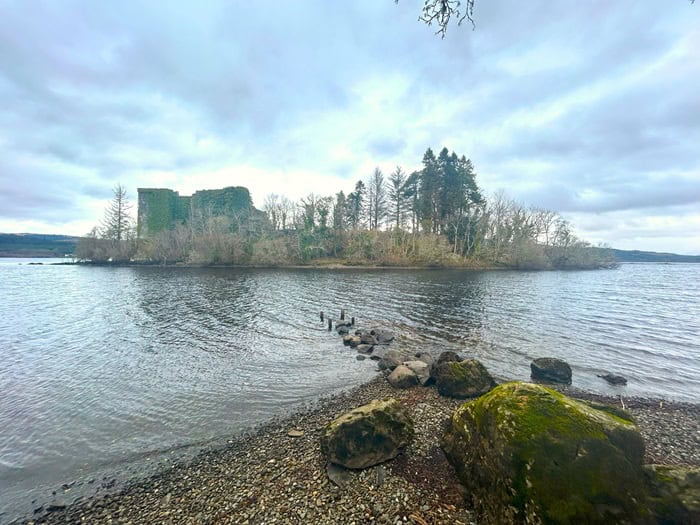
This post may contain affiliate links. Please read our disclosure and privacy policy for more.
I’ve visited many castles across England and Scotland. This one stood out because the island is accessible by boat, and you can explore the ruins. Being unprepared, aka minus a boat, I pondered what the insides looked like, what it would be like to explore, and an urge to spend the night on the island. It’s also the first castle captured with my drone, further fueling my desire to return.
History of Innes Chonnel Castle
The castle stands on the wooded island of Innis Chonnel and has thick outer walls. The existing buildings belong to several different periods. The earliest surviving building is the inner bailey, erected in the first half of the 13th century.
Clan Campbell
Innes Chonnel Castle was one of the earliest Campbell strongholds, certainly from as early as 1308 until the present day. The massive walls of Innes Chonnel crown the rocky southwestern end of a small island halfway down the eastern shore of Loch Awe.
As early as the 11th century, the Campbells owned the castle, and it served as their main stronghold until the late 15th century. The castle was the seat of Sir Cailean Mór (Sir Colin Campbell) when he died at Red Ford in 1296. Sir Colin Campbell’s son, Neil Campbell was given the Lordship of Loch Awe by Robert the Bruce in 1315 after the MacDougalls were defeated. During the 15th century, the Campbell family abandoned the castle as their residence, but it continued to serve as a prison.
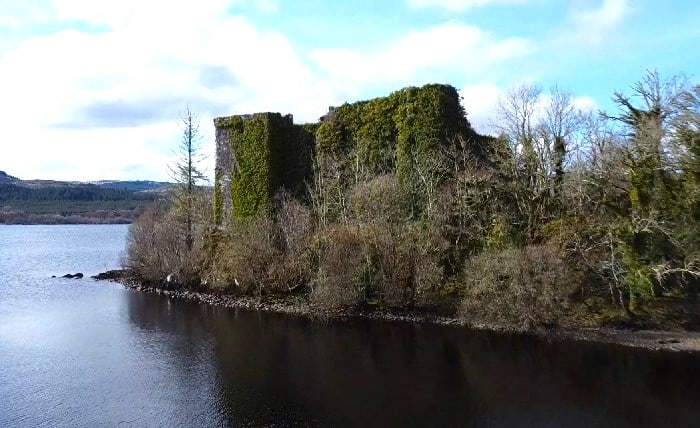
MacDougalls
Records indicate that the MacDougalls built the early castle in the mid-13th century. John of Lorne (MacDougall) held the castle during Edward II’s reign.
Argyll family
Before it was abandoned in the 18th century, the castle was occupied by Campbell officers, later earls of Argyll.
Today, the castle is privately owned by the Argyll family and is not open to the general public. While privately owned, visitors can explore the castle’s remains, including the thick outer walls and the inner bailey, and enjoy the stunning views of Loch Awe from the island. Some people even camp on the island for the night, something I plan to do when I return.
Defensive Structures
The walls are made of stone and are several feet thick, with arrow slits for defense against attackers. The castle was built to withstand sieges and attacks, and its location on an island made it difficult for enemies to approach.
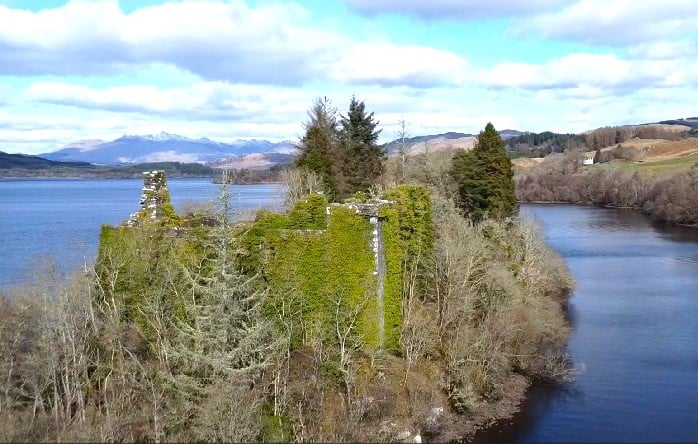
Residential Areas
Innis Chonnel was initially spread out on an arrangement like Palace Sween, constructed 100 to 150 years earlier. At Dunstaffnage, the stone stage was more significant, permitting a more extensive patio, and the more honed corners directed by, the more three-sided plan made the round corner towers essential. This more refined plan component was not utilized in the first plans at Palace Sween or Innis Chonnel.
Innes Chonnel appears to have remained substantially unchanged for the first 150 to 200 years after construction. During the central portion of the fifteenth hundred years, no doubt in the hour of Duncan, first Ruler Campbell, the entire palace was essentially rebuilt.
This is an atrial view of the ruin today:
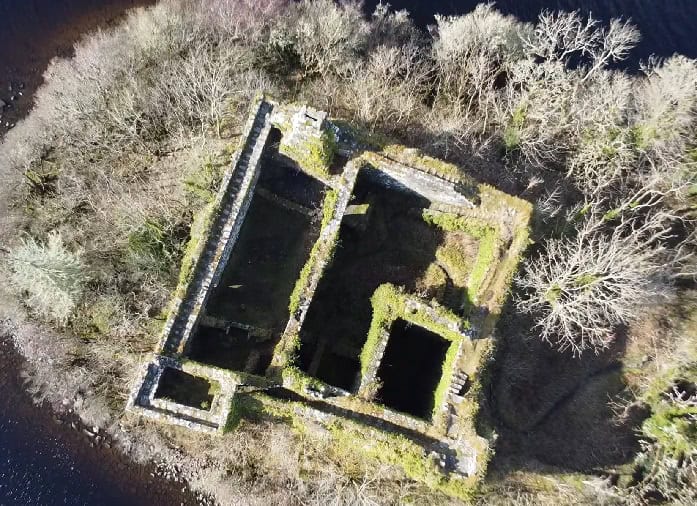
At the eastern corner, the only stone building standing out from the original walls into the courtyard was altered at ground level to create a new gateway and extended upwards to accommodate more people. Another pinnacle was developed at the southern corner and outside the first walls. A new range with vaulted cellars and storerooms on the ground floor and a large Great Hall above, likely with a roof of timber trusses, was constructed down the southwest side of the courtyard. The Hall had a pantry and kitchen at one end and a chamber in the southern tower at the other. Access was by an external step in the western corner of the patio. The chamber’s floor contained a hatch that led to a dungeon. The Corridor had a display over the storage space or ‘screens.’ Warming for the Lobby seems to have been done by a focal hearth, as there is no proof that a chimney, for example, is tracked down in the Kitchen and Chamber.
Upper east of the palace and outside the primary entryway, there is a ‘center bailey’ or open entry court, which is comparable in size to the arrangement of the actual palace. Pasts are the vestiges of a Gatehouse, beyond which the guarded walls of the ‘external bailey’ can, in any case, be recognized, evading an oval level currently dressed in trees.
The study of the Illustrious Commission on Antiquated Landmarks reports: “The palace has minimal written history. It was probably built on Loch Awe by a Campbell family member who was the founding member. Little is known about the Campbell family before Sir Colin (Mor) Campbell showed up at the end of the 13th century. The actual palace was first explicitly referenced in October 1308, when it was being held by John of Lorne for Edward II (of Britain), yet it was in all likelihood one of three MacDougall palaces referenced, however not named, by John in a notable letter kept in touch with Edward presumably in the Spring of that very year.”
Video Of Loch Awe’s Innes Chonnel Castle
This is my drone debut. I wish I could say I captured the footage, but I had assistance from an acquaintance. I did, however, edit all the footage and create the video! I am still learning to use my drone, so this will be one of many.
Strategic Importance
As a stronghold of Clan Campbell, one of the most powerful clans in Scotland. The castle’s location on a small rocky island made it an ideal defensive position, and it was strategically positioned to control access to Loch Awe, a vital transportation route in medieval times.
Its proximity to other essential castles, such as Kilchurn Castle and Fincharn Castle, enhanced its strategic importance. These castles formed a defensive network that controlled the western approaches to the Scottish Highlands and provided a line of defense against potential invaders.
In addition to its military importance, Innes Chonnel Castle also played a significant role in medieval Scotland’s political and economic life. The castle was a center of power and influence, and the Campbell clan used it to assert their authority over the surrounding area.
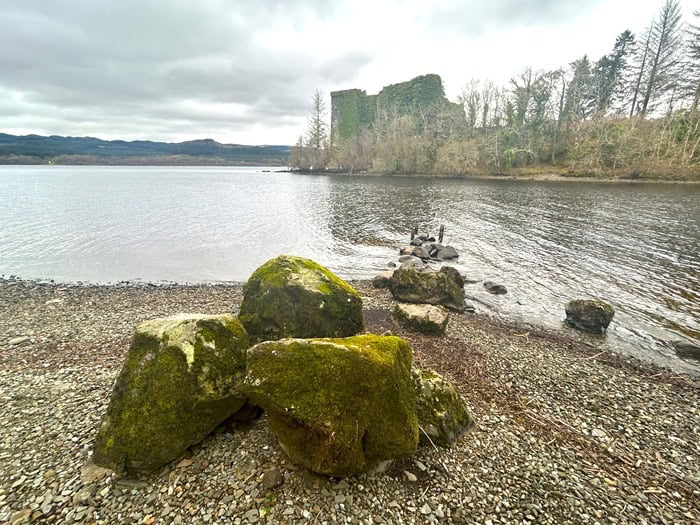
Sieges and Battles
Innes Chonnel Castle has a long and storied history, and as such, it has been the site of many sieges and battles over the centuries.
Battle of Red Ford, 1296: Clan Campbell chief Cailean Mór (Sir Colin Campbell) was killed in a border dispute with the MacDougalls, strained relations between the two clans.
1308: John MacDougall, on behalf of Edward II, held the castle against Robert the Bruce
1314: Sir Neil Campbell, son of Sir Colin Campbell, fought for the Bruce at the Battle of Bannockburn
1315: After the MacDougalls were defeated, Robert the Bruce ordered the Lordship of Loch Awe to revert to Neil Campbel
Current Ownership of Innes Chonnel Castle
The Argyll family still owns the castle privately, and it is not open to the public. However, people do access the castle via boat. If you don’t have a boat (an inflatable watercraft is an easy solution), you can view it from the shore road along the east side of the loch.
Boat Rentals on Loch Awe
Sadly, I could not find one company that rents boats. There are club memberships and some companies offering cruises. Most people rent from where they stay, so double-check that boat rentals or kayaks are available if you plan to stay like I did.
Also, remember that Loch Awe is a large and exposed lake. The weather is prone to change quickly and without warning. Depending on where you start from, it could be quite the paddle to the castle.
When I return, I plan to use an inflatable dingy. The castle is about 50 meters from the bank and will be a leisurely paddle.
Where To Stay On Loch Awe
Nearby Attractions
Several other attractions in the area are open to visitors. The nearby Kilchurn Castle, located on the northern shore of Loch Awe, is an impressive ruined castle open to the public and offers stunning views of the surrounding area.
Several hiking trails in the area offer breathtaking views of the Loch Awe and the surrounding mountains. The trails range in difficulty and length, making them suitable for hikers of all skill levels. Visitors can also enjoy fishing, boating, and other outdoor activities in the Loch Awe.
Frequently Asked Questions
What is the historical significance of Innes Chonnel Castle?

The fortress was once a stronghold of Clan Campbell, one of the most powerful clans in Scotland. The castle has a rich history, and its ruins are a testament to the architectural and engineering prowess of the medieval period.
Who has ownership of Innes Chonnel Castle throughout its history?
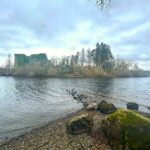
Innes Chonnel Castle has been owned by several prominent families throughout its history. The castle was initially built by the Clan Campbell, who owned it until the late 15th century. Over the centuries, it changed hands several times, with various families owning it for different periods. Today, the castle remains the property of the Duke of Argyll.
Are there guided tours available for Innes Chonnel Castle?
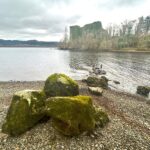
Currently, there are no guided tours available for Innes Chonnel Castle. Visitors can explore the ruins independently but should exercise caution as the site is not maintained and can be dangerous to navigate.
What are the transportation options to reach Innes Chonnel Castle?

Visitors can hire a boat on the loch to take them to the castle. Alternatively, visitors can walk along the shore of the loch and view the castle from a distance.
How does Innes Chonnel Castle relate to the Campbell clan in Scotland?

Innes Chonnel Castle was one of the earliest Campbell strongholds and played an essential role in the clan’s history. The castle was strategically located on an island on Loch Awe, which gave the Campbells control over the loch and the surrounding area. The castle also symbolized the clan’s power and influence in Scotland.
What are some of the architectural features of Innes Chonnel Castle?

Innes Chonnel Castle is a prime example of medieval castle architecture. It was built using local stone and features several architectural elements, including a drawbridge, a moat, and a courtyard. The castle also has several towers and turrets used for defense and lookout purposes. The castle’s ruins are a testament to the skill and craftsmanship of the medieval builders.
Closing Thoughts
Innes Chonnel Castle has captured my imagination. The dungeon on-site alone is something I want to explore. Imagine what type of torture went on in the dungeon! The idea of camping on Innis Island and the mystery surrounding the ruin make it one of my favorite castles in Scotland.
The castle is in a stunning location on Loch Awe, and intricate architecture makes it a must-see destination for history buffs and architecture enthusiasts alike.
The castle is remote, and there is virtually no tourism, so you’ll probably get the entire place to yourself.
It’s also a great place to fish! In the summer, you could spend a day swimming in the lock, enjoying a picnic, and then camping on the island at night! Which is precisely what I plan to do when I return.
Looking For More In Scotland? Start Here:
- Loch an Eilein: A Serene Highland Lake in Scotland
- Scottish Pyramids: The Balmoral Cairns
- Scotlands Green Loch “An Lochan Uaine” In Glenmore Forest
- Urquhart Castle – The Jaw-dropping Castle On The Bank Of Loch Ness
Brit On The Move™ Travel Resources
Ready to book your next trip? Use these resources that work:
Was the flight canceled or delayed? Find out if you are eligible for compensation with AirHelp.
- Book your Hotel: Find the best prices; use Booking.com
- Find Apartment Rentals: You will find the best prices on apartment rentals with Booking.com’s Apartment Finder.
- Travel Insurance: Don’t leave home without it. View our suggestions to help you decide which travel insurance is for you: Travel Insurance Guide.
- Want to earn tons of points and make your next trip accessible? Check out our recommendations for Travel Credit Cards.
- Want To Take A Volunteer Vacation or a Working Holiday? Check out the complete guide to how here!
- Want to Shop For Travel Accessories? Check out our Travel Shop.
Need more help planning your trip? Visit our Resources Page, which highlights the great companies we use for traveling.
We participate in the Amazon Services LLC Associates Program, an affiliate advertising program designed to earn fees by linking to Amazon.com and affiliated sites
“Brit on the Move explores the rich history of Innes Chonnel Castle, offering an engaging narrative of Loch Awe’s iconic Scottish fortress.”